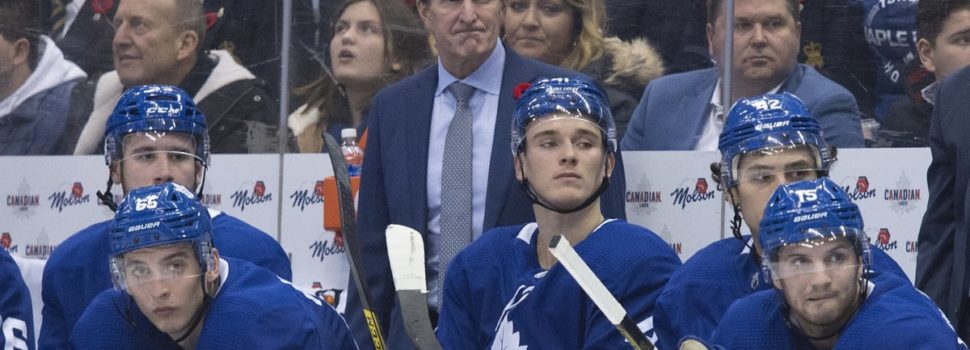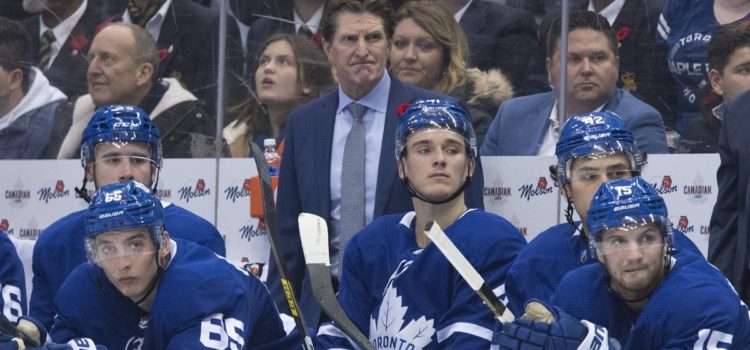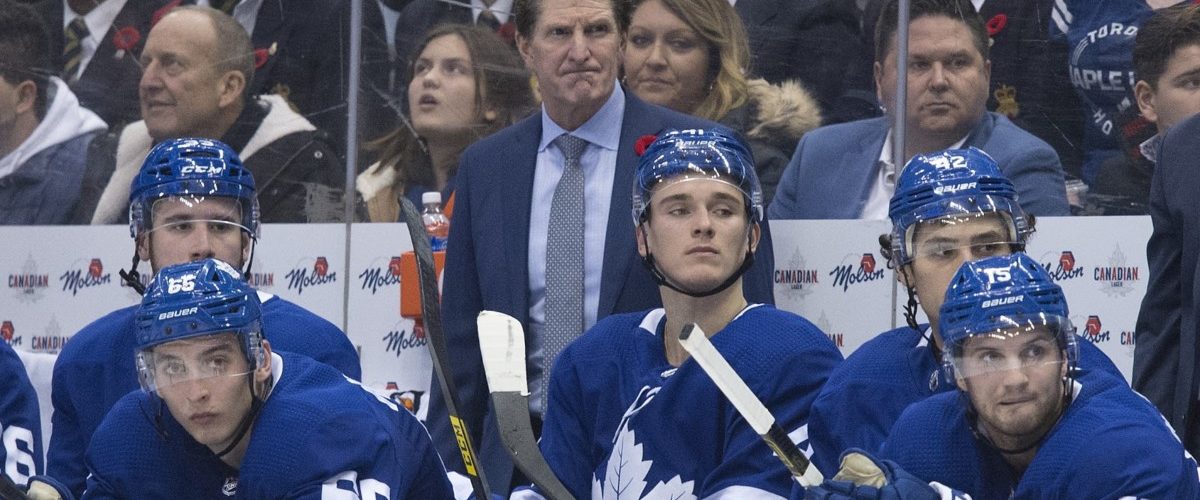

OPINION: Toronto Maple Leafs problems go further than Mike Babcock
OpinionSportsToronto Nov 22, 2019 Christian Holmes

Not too long ago, the Toronto Maple Leafs were the National Hockey League’s biggest joke. The Maple Leafs had only won 30 games in the 2014-15 season and morale was low since most players knew a rebuild was coming. The tank for Connor McDavid had been in full force and the “Shanaplan” was slowly starting to come into play. Optimism was high for fans with the hopes of a brighter future, but when one roll of the ball did not go Toronto’s way in the 2015 NHL Draft Lottery, Leafs Nation was hit with another letdown, another cruel joke.
Of course, with hindsight being 20/20, the Leafs still lucked out with the fourth overall pick. A pick that most thought was going to be a bust since everyone wanted to see the generational talent McDavid in a Leafs uniform. The draft pick would be used to draft John Tavares’ new best buddy, Mitch Marner. The rest is history.
Maple Leafs fans today often forget how much it meant to them when Babcock decided to come to the team.
After the disappointment of yet another losing season and a poor result at the Draft Lottery, Leaf fans focused their sights on a new head coach.
Word got out that Detroit Red Wings accomplished head coach Mike Babcock would be coming to Toronto and Leafs Nation went into a frenzy, as it usually does with news like this.
The Maple Leafs inked Mike Babcock to an eight-year, $80-million contract less than a month after the NHL Draft Lottery.
Just like that, the “Shanaplan” was in motion, although Babcock, after his firing, would credit Chairman of Maple Leaf Sports & Entertainment Larry Tanenbaum for getting him to turn down other offers to come and coach the Leafs back to relevance. Fans speculated Babs was taking a jab at the Leafs front office.
Babcock famously said that “there would be pain” in the rebuild process and that was true. In Babcock’s first year with the Maple Leafs, the team finished the 2015-16 season with a losing record of 29-42-11, good enough to get franchise centre Auston Matthews with the first overall pick in the 2016 NHL Entry Draft. The next year, the Leafs shocked some people and battled it out with the Washington Capitals in the first round of the playoffs, taking the Caps to six games before losing.
Each year up until the 2019-20 season, Babcock coached the team to the playoffs and new franchise records. Babcock’s presence alone was much of the reason GMr Kyle Dubas and Co. convinced hometown boy John Tavares to make the jump from Long Island to the 6ix.
Then Babcock and the Leafs fell on black days at the start of the 2019-20 season. The team started the year with a 9-10-4 record. After a loss to the Vegas Golden Knights on Monday night, Dubas and president Brendan Shanahan dropped the axe on Babcock’s tenure in Toronto. It was not unexpected.
Dubas, the analytical genius, has metrics on his side to support his firing of the Stanley Cup-winning coach.
The team had been on a six-game losing streak. Toronto’s playoff chances went from being a near-lock at 95 per cent at the start of the season to its current status as a playoff bubble team at 59 per cent, according to The Athletic’s Dom Luszczyszyn projections. MoneyPuck made Luszczyszyn’s projections look generous, with the website’s projections only giving the Maple Leafs a 31.8 per cent chance at making the playoffs.
Usually figures like these mean a good team is playing well below its caliber. That is a problem which almost always lands on the coach. And this is what happened to Babcock in Toronto.
Babcock had usually been ahead of the game when it came to pulling the goalie, according to work done by Meghan Hall, with the Leafs leading the league in each of his first four seasons, going from an average time of 2:04 in 2015-16 to 2:25 last season. Luszczyszyn calculates this year that’s dropped to 1:49, just barely above the league average.
It also does not help that through 23 games, the Leafs rank sixth last in 5-on-5 expected goals percentage at 47.1 per cent. As Luszczyszyn said, Babcock’s four years here are the only time the team was ever worse during a 23-game stretch was near the end of the 2015-16 season when the team finished in last place.
According to Luszczyszyn’s projections, Toronto’s special teams units have been terrible to start the year with the power play scoring just 6.2 goals-per-60 (19th in the league) and the penalty kill allowing 9.2 goals against per 60 (26th in the league). For a team like the Maple Leafs, who are supposed to excel on special teams, these numbers are just another black eye.
The numbers do not lie. Babcock did deserve his fate. It was obvious the team was not playing for him. His way of doing things was getting old. Patience was wearing thin for Babcock to adapt to the changing times. Everyone from fans to hockey analysts wanted Babcock to utilize his lines to their full potential. When he proved nothing was going to change and he continued to bet on his old ways, it was time for the Leafs front office to make a change.
But not every fan thinks this change will “fix” the Maple Leafs.
Longtime Leafs fanatic Mario Domanico told Skedline.com he did not like the firing of Babcock and said all he wants is for the Leafs to win a Cup.
“I don’t want to get rid of Babcock because he has done so much for the team,” Domanico said. “I don’t even know what the team could have done otherwise because of the salary cap being so tight. It’s a tough situation”
Many share Domanico’s opinion.e. It is not like the Leafs’ early-season struggles were all on the coach. The problems run much deeper. And yes, the situation is tough.
An old mantra in sports is when a coach gets fired, the players share much of the blame. Politely put, the Leafs did not show up for Babcock in his final days in Toronto. They were not buying into Babcock’s “keep grinding” mentality and they did anything but “grind” throughout the first quarter of the 2019-20 season.
When players were not able to use long stretch passes to break out of their zone and create scoring opportunities at the other end of the ice, the Leafs looked lost and unwilling to adapt. Their backchecking or lack of it led to many scoring chances against (SCA) and probably lost them some games along the way.
That is not on the coach. The players might be trying to play the coach’s system, but it is their job to make adjustments when things are not working
Other fans feel Dubas “messed up” the Leafs salary cap.
Donald Ibro told Skedline.com the Leafs made the right move to get rid of Mike Babcock but said he believes this will not change much of anything.
“Babcock had to go. A change was needed,” said Ibro. “His firing might not change much in the long run though. The cap issues are going to hurt Toronto. Dubas overpaid a few players and left the team with not too much room to work with going forward.”
Dubas has made some questionable moves this past offseason. The GM gave Mitch Marner a big six-year, $65.358 million payday. Media pundits such as Sportsnet’s Brian Burke also argue Dubas overpaid Matthews and Nylander on their extensions leaving over 40 per cent of Toronto’s cap tied up in four players (Matthews, Tavares, Marner, and Nylander).
Some fans also criticize Dubas for not fixing the Leafs backup goalie situation after he traded Garret Sparks to the Vegas Golden Knights during the offseason. Fans became more upset with Dubas’ decision after Michael Hutchinson started the season 0-4-1 with a goals-against-average of 4.44 and a save percentage of .879, and the team had to put him on waivers.
To make things worse, sportswriters like Damien Cox have called out Dubas for not trying to fix the Leafs defensive woes by acquiring a gritty stay-at-home defenceman.
To be fair to Dubas, he did address the situation by acquiring Tyson Barrie over the summer. Some do not like the fact that the Leafs had to give up the grittiest player on the team last year, centreman Nazem Kadri, to get Barrie. The team did get back Alexandre Kerfoot, a serviceable third-line centreman, but Barrie is known for being an offensive-minded defenceman whose defensive metrics are not that stellar.
Cox wanted the Maple Leafs to acquire someone like St. Louis Blues 6’3″ defenseman Alex Pietrangelo, who was rumoured to be on the market before St. Louis’ surprising Stanley Cup run. The belief was Chicago and Pittsburgh got lucky that their speed and skill plan paid off when they won their Cups. Hockey purists believed it could not work again. And even if it were to work again, the Leafs are not as good as those teams where when they won.
The front office for the Maple Leafs says it wants to hold its organization more accountable.
Now that Babcock is gone, Dubas and Co. will have to face the music if their plan to combine speed and skill does not stand up to the test of time. If this nightmare of a season does not turn around quickly, the team’s young stars and a young general manager will have to fend off the pitchforks from Leafs fans who are tired of losing. Another year of disappointment will not be tolerated from a fan base that has been waiting for a Stanley Cup victory since 1967.
